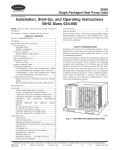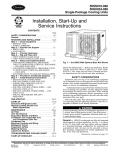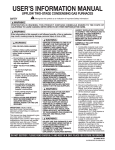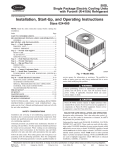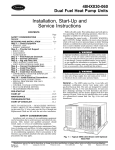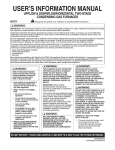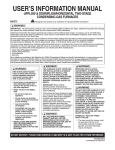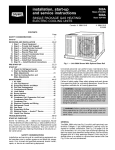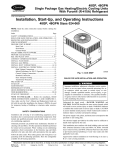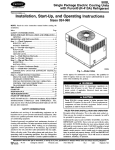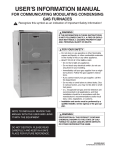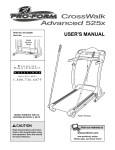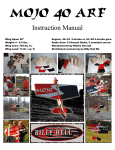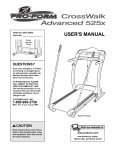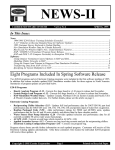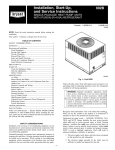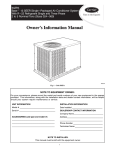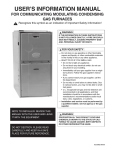Download Installation, Start-Up, and Operating Instructions
Transcript
50SX Single Packaged Electric Cooling Units Visit www.carrier.com Installation, Start-Up, and Operating Instructions 50SX Sizes 024-060 NOTE: Read the entire instruction manual before starting the installation. This symbol → indicates a change since the last issue. TABLE OF CONTENTS SAFETY CONSIDERATIONS .....................................................1 Introduction ....................................................................................2 RECEIVING AND INSTALLATION ..........................................2 Check Equipment......................................................................2 IDENTIFY UNIT ................................................................2 INSPECT SHIPMENT ........................................................2 Provide Unit Support ................................................................2 ROOF CURB & SLAB MOUNT.......................................2 Provide Clearances....................................................................2 Select and Install Ductwork .....................................................2 Rig and Place Unit....................................................................3 INSTALLATION ................................................................5 Connect Condensate Drain .......................................................6 Install Duct Connections ..........................................................7 CONFIGURING UNITS FOR DOWNFLOW (VERTICAL) DISCHARGE-STANDARD UNITS (024–042)......8 CONFIGURING UNITS FOR DOWNFLOW (VERTICAL) DISCHARGE-ECM UNITS (048–060).................11 Install Electrical Connection ..................................................14 HIGH-VOLTAGE & CONTROL-VOLTAGE CONNECTIONS................................................................................14 SPECIAL PROCEDURES FOR 208-V OPERATION ...14 Troubleshooting............................................................................29 Start-Up Checklist ........................................................................30 NOTE TO INSTALLER — Before the installation, READ THESE INSTRUCTIONS CAREFULLY AND COMPLETELY. Also, make sure the User’s Manual and Replacement Guide are left with the unit after installation. SAFETY CONSIDERATIONS Installation and servicing of air-conditioning equipment can be hazardous due to system pressure and electrical components. Only trained and qualified personnel should install, repair, or service air-conditioning equipment. Untrained personnel can perform basic maintenance functions of cleaning coils and filters. All other operations should be performed by trained service personnel. When working on air-conditioning equipment, observe precautions in the literature, tags, and labels attached to the unit, and other safety precautions that may apply. Follow all safety codes. Wear safety glasses and work gloves. Use quenching cloth for unbrazing operations. Have fire extinguisher available for all brazing operations. Consult a qualified installer or service agency for information or assistance. The qualified installer or agency must use only factory-authorized kits or accessories when modifying this product. PRE-START-UP ..........................................................................17 START-UP ...................................................................................17 CHECK FOR REFRIGERANT LEAKS..........................17 START UP COOLING SECTION AND MAKE ADJUSTMENTS ..............................................................................18 CHECKING COOLING CONTROL OPERATION .......18 CHECKING AND ADJUSTING REFRIGERANT CHARGE ...........................................................................18 INDOOR AIRFLOW AND AIRFLOW ADJUSTMENTS ..............................................................................18 For 208/230v-PSC Blower Motor.....................................18 For 208/230v-ECM Blower Motor ...................................21 COOLING SEQUENCE OF OPERATION.....................21 HEATING SEQUENCE OF OPERATION .....................21 MAINTENANCE.........................................................................21 AIR FILTER......................................................................23 UNIT TOP REMOVAL ....................................................23 EVAPORATOR BLOWER AND MOTOR.....................23 CONDENSER COIL, EVAPORATOR COIL, AND CONDENSATE DRAIN PAN ..................................................26 CONDENSER FAN ..........................................................27 ELECTRICAL CONTROLS AND WIRING ..................27 REFRIGERANT CIRCUIT...............................................28 EVAPORATOR AIRFLOW .............................................28 METERING DEVICE — ACUTROL DEVICE .............28 LIQUID LINE STRAINER ..............................................28 C95002 Fig. 1—Unit 50SX with Optional Base Rails Manufacturer reserves the right to discontinue, or change at any time, specifications or designs without notice and without incurring obligations. Book 1 6 PC 101 Catalog No. 535–00102 Printed in U.S.A. Form 50SX-2SI Pg 1 7–03 Replaces: 50SX-1SI Tab 6 8 all 4 sides of the unit. Install a 6-in. gravel apron in front of condenser-air inlet to prevent obstruction of airflow by grass or shrubs. Do not secure the unit to the slab except when required by local codes. Before performing service or maintenance operations on system, turn off power to unit. Turn off accessory heater power switch, if applicable. Electrical shock can cause personal injury. Step 3—Provide Clearances The required minimum service clearances are shown in Fig. 2-5. Adequate ventilation and outdoor air must be provided. The outdoor fan pushes air through the outdoor coil and discharges it through the louvers on the top cover, the decorative grille, and the compressor access panel. Be sure that the fan discharge does not recirculate to the outdoor coil. Do not locate the unit in either a corner or under an overhead obstruction. The minimum clearance under a partial overhang (such as a normal house overhang) is 48 in. above the unit top. The maximum horizontal extension of a partial overhang must not exceed 48 in. Recognize safety information. This is the safety-alert symbol . When you see this symbol in instructions or manuals, be alert to the potential for personal injury. Understand the signal words DANGER, WARNING, CAUTION, and NOTE. These words are used with the safety-alert symbol. DANGER identifies the most serious hazards which will result in severe personal injury or death. WARNING signifies a hazard which could result in personal injury or death. CAUTION is used to identify unsafe practices which would result in minor personal injury or product and property damage. NOTE is used to highlight suggestions which will result in enhanced installation, reliability, or operation. IMPORTANT: Do not restrict outdoor airflow. An air restriction at either the outdoor-air inlet or the fan discharge may be detrimental to compressor life. Do not place the unit where water, ice, or snow from an overhang or roof will damage or flood the unit. Do not install the unit on carpeting or other combustible materials. Slab-mounted units should be at least 4 in. above the highest expected water and runoff levels. Do not use unit if it has been under water. These instructions cover minimum requirements and conform to existing national standards and safety codes. In some instances, these instructions exceed certain local codes and ordinances, especially those that may not have kept up with changing residential construction practices. We require these instructions as a minimum for a safe installation. INTRODUCTION The 50SX units (see Fig. 1) are fully self-contained, and designed for outdoor installation. See Figs. 2–5 for unit dimensions. All units are shipped in a horizontal-discharge configuration for installation on a ground-level slab. All units can be converted to down-flow discharge configurations for rooftop applications. (See Fig. 6 for roof curb dimensions.) RECEIVING AND INSTALLATION Step 1—Check Equipment Step 4—Select and Install Ductwork The design and installation of the duct system must be in accordance with the standards of the NFPA (National Fire Protection Association) for installation of nonresidence-type air conditioning and ventilating systems, NFPA90A or residencetype, NFPA90B; and/or local codes and residence-type, NFPA90B; and/or local codes and ordinances. Select and size ductwork, supply-air registers and return-air grilles according to ASHRAE (American Society of Heating, Refrigeration, and Air Conditioning Engineers) recommendations. The unit has duct flanges on the supply- and return-air openings on the side of the unit. See Fig. 2-5 for connection sizes and locations. When designing and installing ductwork, consider the following: IDENTIFY UNIT The unit model number and serial number are stamped on the unit identification plate. Check this information against shipping papers. INSPECT SHIPMENT When connecting ductwork to units, do not drill deeper than 1/2–in. in shaded area shown or coil may be damaged. Inspect for shipping damage while unit is still on shipping pallet. If unit appears to be damaged or is torn loose from its anchorage, have it examined by transportation inspectors before removal. Forward claim papers directly to transportation company. Manufacturer is not responsible for any damage incurred in transit. Check all items against shipping list. Immediately notify the nearest distributor if any item is missing. To prevent loss or damage, leave all parts in original packages until installation. 1. All units should have field-supplied filters or accessory filter rack installed in the return-air side of the unit. Recommended sizes for filters are shown in Table 1. 2. Avoid abrupt duct size increases and reductions. Abrupt change in duct size adversely affects air performance. IMPORTANT: Use flexible connectors between ductwork and unit to prevent transmission of vibration. Use suitable gaskets to ensure weathertight and airtight seal. When electric heat is installed, use fireproof canvas (or similar heat resistant material) connector between ductwork and unit discharge connection. If flexible duct is used, insert a sheet metal sleeve inside duct. Heat resistant duct connector (or sheet metal sleeve) should extend 24-in. from electric heater element. Step 2—Provide Unit Support ROOF CURB & SLAB MOUNT ROOF CURB - Install accessory roof curb in accordance with instructions shipped with curb (See Fig. 6). Install insulation, cant strips, roofing, and flashing. Ductwork must be attached to curb. IMPORTANT: The gasketing of the unit to the roof curb is critical for a watertight seal. Install gasketing material supplied with the roof curb. Improperly applied gasketing also can result in air leaks and poor unit performance. 3. Size ductwork for cooling air quantity (cfm). The minimum air quantity for proper electric heater operation is listed in Table 2. Heater limit switches may trip at air quantities below those recommended. NOTE: A 90-degree elbow must be provided in the supply ductwork to comply with UL (Underwriters’ Laboratories) codes for use with electric heat. Curb should be level to within 1/4 in (See Fig. 8A). This is necessary for unit drain to function properly. Refer to accessory roof curb installation instructions for additional information as required. SLAB MOUNT - Place the unit on a solid, level concrete pad that is a minimum of 4 in. thick with 2 in. above grade (See Fig. 8B). The slab should extend approximately 2 in. beyond the casing on 4. Insulate and weatherproof all external ductwork. Insulate and cover with a vapor barrier all ductwork passing through 2 C95003 UNIT ELECTRICAL CHARACTERISTICS 50SX024 50SX030 50SX036 208/230-1-60 208/230-1-60 208/230-1-60, UNIT WEIGHT lb. 270 273 291 kg 122 124 132 A 67/30 66/30 80/36 CORNER WT LB/KG B C 62/28 99/45 64/29 100/45 54/25 112/51 D 42/19 43/20 45/20 CENTER OF GRAVITY IN/MM X Y Z 21.7/552 20.7/527 12.7/321 21.9/556 20.7/525 12.7/321 20.8/525 20.0/507 12.7/321 Fig. 2— 50SX024-036 Unit Dimensions (without base rails) or accessory roof curb must be level before setting the unit in place. When a field-fabricated support is used, be sure that the support is level and that it properly supports the unit. UNITS WITHOUT BASE RAILS-Accessory rigging brackets are recommended to be used for rigging. Install brackets as follows: conditioned spaces. Follow latest Sheet Metal and Air Conditioning Contractors National Association (SMACNA) and Air Conditioning Contractors Association (ACCA) minimum installation standards for residential heating and air conditioning systems. 5. Secure all ducts to building structure. Flash, weatherproof, and vibration-isolate duct openings in wall or roof according to good construction practices. Step 5—Rig and Place Unit Use spreader bars or crate top when rigging the unit. The units must be rigged for lifting as shown in Fig. 7. Use extreme caution to prevent damage when moving the unit. Unit must remain in an upright position during all rigging and moving operations. The unit must be level for proper condensate drainage; the ground-level pad 3 C95004 UNIT ELECTRICAL CHARACTERISTICS 50SX024 50SX030 50SX036 208/230-1-60 208/230-1-60 208/230-1-60, UNIT WEIGHT lb. 290 293 311 kg 132 133 142 A 72/33 71/32 85/39 CORNER WT LB/KG B C 67/30 104/47 69/31 105/48 59/27 117/53 D 47/21 48/22 50/23 CENTER OF GRAVITY IN/MM X Y Z 21.5/546 20.8/528 15.1/380 21.7/550 20.7/527 15.1/380 20.6/524 20.1/510 15.1/380 Fig. 3— 50SX024-036 Unit Dimensions (with base rails) 2. Position paint protectors and foam strips between screws and painted surface of unit. Tighten screws until they make contact with the paint protectors. Secure screws and paint protectors solidly against unit base to hold lifting brackets in position. Never use lifting brackets when the temperature is below -10 F (-23 C). Never exceed 200 lbs per bracket of lifting force. Never use lifting brackets for lifting other models of air conditioning units. Lifting point should be directly over the unit center of gravity. Failure to follow this warning could result in personal injury or death. 3. Secure device or hook of sufficient strength to hole in bracket as shown in detail ’’C’’ of Fig. 7. 4. If wood top is available, use it for a spreader bar to prevent straps from damaging unit. If wood top is not available, use spreader bars of sufficient length. UNITS WITH OPTIONAL BASE RAILS - Keep unit upright and do not drop. Use spreader bars or top crate when rigging unit. Rollers may be used to move unit across roof. Level unit for proper 1. Position brackets as close to the corners of unit as possible. Be sure brackets are well outside of center of gravity (See Fig. 2-5, and 7). 4 C95005 UNIT ELECTRICAL CHARACTERISTICS 50SX042 50SX048 50SX060 208/230-1-60 208/230-1-60 208/230-1-60, UNIT WEIGHT lb. 309 340 359 kg 140 155 163 A 84/38 84/38 65/30 CORNER WT LB/KG B C 59/27 119/54 70/32 133/60 99/45 120/55 D 47/21 53/24 75/34 CENTER OF GRAVITY IN/MM X Y Z 21.1/533 20.1/510 15.4/390 21.8/553 19.7/499 15.4/390 22.2/565 19.8/503 13.4/340 Fig. 4— 50SX042-060 Unit Dimensions (without base rails) 3. Tighten the ratchet strap unit tight. Lifting brackets should be secure in the rigging holds. 4. Attach the clevis or hook of sufficient strength to hole in the lifting bracket (See Fig. 7). 5. Attach safety straps directly to the field supplied rigging straps or clevis clip. Do not attach the safety straps to the lifting brackets. 6. Use the top of the unit as a spreader bar to prevent the rigging straps from damaging the unit. If the wood top is not available, use a spreader bar of sufficient length to not damage the unit. condensate disposal. See Fig. 7 for additional information. Lifting holes are provided in base rails as shown in Fig. 7, See Detail “A” or “B-B”. Refer to rigging instructions on unit. INSTALLATION 1. Position the lifting bracket assembly around the base of the unit. Leave the top shipping skid on the unit to act as a spreader bar. Be sure the strap does not twist. 2. Place each of the four (4) metal lifting brackets into the rigging holds in the composite pan. 5 C95006 UNIT ELECTRICAL CHARACTERISTICS 50SX042 50SX048 50SX060 208/230-1-60 208/230-1-60 208/230-1-60, UNIT WEIGHT lb. 329 360 379 kg 150 164 172 A 89/40 89/40 70/32 CORNER WT LB/KG B C 64/29 124/56 75/34 138/63 104/47 125/57 D 52/24 58/26 80/36 CENTER OF GRAVITY IN/MM X Y Z 20.8/529 20.2/512 17.3/440 21.6/548 19.8/502 17.3/440 22.0/560 19.9/506 15.7/399 Fig. 5— 50SX042-060 Unit Dimensions (with base rails) installations (where permitted) or onto a gravel apron in groundlevel installations. Install a field-supplied condensate trap at end of condensate connection to ensure proper drainage. Make sure that the outlet of the trap is at least 1-in. lower than the drain-pan condensate connection to prevent the pan from overflowing. Prime the trap with water. When using a gravel apron, make sure it slopes away from the unit. If the installation requires draining the condensate water away from the unit, install a 2-in. trap using a 3/4-in. NPT connection. See Fig. 15. Make sure that the outlet of the trap is at least 1-in. lower than the unit drain-pan condensate connection to prevent the pan from overflowing. Prime the trap with water. Connect a drain tube using a minimum of 3/4-in. PVC, 3/4-in. CPVC, or 3/4-in. copper pipe (all field supplied). Do not undersize the tube. Pitch Lifting point should be directly over the center of gravity for the unit. Failure to follow this warning could result in personal injury or death. Step 6—Connect Condensate Drain NOTE: When installing condensate drain connection be sure to comply with local codes and restrictions. Unit disposes of condensate through a 3/4-in. NPT fitting which exits through the compressor access panel. See Fig. 2–5 (Front View) for location of condensate connection. Condensate water can be drained directly onto the roof in rooftop 6 C95007 ODS CATALOG NUMBER Flat Curb CPRFCURB001A00 CPRFCURB002A00 CPRFCURB003A00 A IN. (MM) 8 (203) 11 (279) 14 (356) Fig. 6— Roof Curb Dimensions from the unit discharge connection flange into the ductwork. the drain tube downward at a slope of at least 1 in. for every 10 ft of horizontal run. Be sure to check the drain tube for leaks. Prime trap at the beginning of the cooling season start-up. ACCESSORY DUCT FLANGE KIT INSTALLATION1. Mark hole locations (See instructions included in Flange Kit). Step 7—Install Duct Connections The unit has duct flanges on the supply- and return-air openings on the side and bottom of the unit. For downshot applications the ductwork can be connected to the roof curb. See Fig. 2-5 for connection sizes and locations. Do not drill deeper than 1/2–in. into area between round duct openings. Damage to refrigerant coil could result. 2. At marked locations, drill holes using a no. 26 (.147-in.) twist drill (See Fig. 16). IMPORTANT: Use flexible connectors between ductwork and unit to prevent transmission of vibration. Use suitable gaskets to ensure weathertight and airtight seal. When electric heat is installed, use fire proof canvas (or similar heat resistant material) connector between ductwork and unit discharge connection. If flexible duct is used, insert a sheet metal sleeve inside duct. Heat resistant duct connector (or sheet metal sleeve) must extend 24-in. 3. Partially secure duct flanges using two of the no. 10, 1/2-in. screws provided. 4. See the following caution. Using remaining holes in duct flanges as templates, drill the remaining holes with the no. 26 (.147-in.) drill. 7 060 398 180 14.4 366 38.2 969.0 060 411 186 16.25 412 34.12 867 C95009 Fig. 7—50SX Rigging Instructions A C MAXIMUM ALLOWABLE DIFFERENCE (in.) B A-B B-C A-C 1/4 1/4 1/4 C99065 Fig. 8A—Unit Leveling Tolerances CONFIGURING UNITS FOR DOWNFLOW (VERTICAL) DISCHARGE-STANDARD UNITS (024–042) Units 024–042 (Units with PSC Indoor Blower Motors) are shipped in a horizontal configuration. To convert a horizontal unit for downflow (vertical) discharge, perform the following steps: 5. Fully secure the duct flanges using the remaining screws provided. NOTE: The finished kit installation accommodates a 14 3/4-in. x 14 3/4-in. duct. 8 REAR SIDE OF UNIT 984 mm (38 3/4”) PAD UNIT OUTLINE 933 mm (36 3/4”) 1110 mm (43 11/16”) SIDE OF UNIT WITH DUCT CONNECTIONS 1161 mm (45 11/16”) SIDE OF UNIT WITH ACCESS PANELS FOR CONTROL BOX AND INDOOR BLOWER HOUSING NOTES: 1. Extend 6-in. gravel apron around pad. 2. Provide a3-ft service clearance at front and rear sides of unit. C95039 Fig. 8B—Unit Leveling Tolerances INDOOR THERMOS TAT RETURN AIR FROM POWER SOURCE TOP COVER DISCONNECT PER NEC C95013 Fig. 9—Typical Unit Installation ACCESS PANEL (REMOVE SCREWS) C95014 Fig. 10—Evaporator Access Panel 9 C95015 Fig. 11—Removing Insulation and Vertical Duct Cover INDOOR BLOWER ACCESS PANEL (REMOVE SCREWS) C950016 Fig. 12—Indoor Blower Access Panel 8. Locate lances in unit base insulation that are placed over the perimeter of the vertical discharge opening cover (See Fig. 11). 9. Using a straight edge and sharp knife, cut the insulation around the perimeter of the cover. Remove the screws securing the cover to the unit base and slide out the cover. Discard the cover. Install filler bracket removed in Step 7. 10. If unit ductwork is to be attached to vertical opening flanges on the unit unit base (jackstand applications only), do so at this time. 11. It is recommended that the unit base insulation around the perimeter of the vertical opening be secured to the unit base with aluminum tape to prevent the insulation from tearing or bunching up when the blower housing is installed in the vertical discharge position. 12. Orient blower housing for vertical airflow (blower motor adjacent to horizontal duct opening) and slide into vertical opening making sure the flanges on the blower side plates engage the tabs in the unit base (See Fig. 13). Resistance will be felt as the blower housing contacts the unit base insulation; this can be overcome by applying a slight force to the base of the blower. Continue sliding blower in until hole in side plate flange aligns with the hole in the unit base. Secure using screw removed in Step 7. Reconnect evaporator-fan motor leads and insert wire tie back into unit control box. Before performing service or maintenance operations on the system, turn off main power to unit and install lockout tag or electrical shock could result. 1. Open all electrical disconnects and install lockout tag before starting any service work. 2. Remove evaporator coil access panel (See Fig. 10). 3. Locate lances in unit base insulation that are placed over the perimeter of the vertical duct opening cover (See Fig. 11). 4. Using a straight edge and sharp knife, cut and remove the insulation around the perimeter of the cover. Remove the screws securing the cover to the unit base and slide out the cover. Discard the cover. 5. Remove indoor blower access panel (See Fig. 12). 6. Disconnect evaporator-fan motor leads from evaporator fan relay and unit contactor. Carefully disengage wire tie containing evaporator-fan motor leads from the unit control box (See Fig. 13). 7. Remove screws securing evaporator blower housing to blower shelf and carefully slide out blower housing. There is a filler bracket attached to the blower shelf; remove this filler bracket and retain for later use (See Fig. 14). 10 BLOWER SHELF FILLER BRACKET RACEWAY PLUG ASSEMBLIES HORIZONTAL DUCT OPENING C950010 Fig. 13—Converting Blower Assembly to Vertical Airflow FILLER BRACKET REMOVE C95017 Fig. 14—Blower Shelf and Housing 1” (25mm) MIN. TRAP OUTLET 2” (50mm) MIN. C99013 Fig. 15–Condensate Trap 13. Cover the horizontal duct openings. Duct covers can be ordered as an accessory or field fabricated (See Fig. 17). Before performing service or maintenance operations on the system, turn off main power to unit and install lockout tag or electrical shock could result. 14. Reinstall the evaporator coil and indoor blower access panels. 15. After completing unit installation, perform all safety checks and power up unit. CONFIGURING UNITS FOR DOWNFLOW (VERTICAL) DISCHARGE-ECM UNITS (048–060) 1. Open all electrical disconnects and install lockout tag before starting any service work. 2. Remove evaporator coil access panel (See Fig. 10). Units 048–060 (Units with ECM Indoor Blower Motors) are shipped in a horizontal configuration. To convert a horizontal unit for downflow (vertical) discharge, perform the following steps: 3. Locate lances in unit base insulation that are placed over the perimeter of the vertical duct opening cover (See Fig. 11). 11 Table 1—Physical Data—Unit 50SX UNIT SIZE NOMINAL CAPACITY (ton) OPERATING WEIGHT (lb.) Without Base Rails WIth Optional Rails COMPRESSOR REFRIGERANT (R-22) Quantity (lb.) REFRIGERANT METERING DEVICE CONDENSER COIL Rows...Fins/in. Face Area (sq. ft.) CONDENSER FAN Nominal Cfm Diameter (in.) Motor Hp (Rpm) EVAPORATOR COIL Rows...Fins/in. Face Area (sq. ft.) EVAPORATOR BLOWER Motor Type Speeds Nominal Airflow (Cfm) Size (in.) Motor Hp (RPM) RETURN-AIR FILTERS (in.) Throwaway 024 2 030 2-1/2 036 3 042 3-1/2 048 4 060 5 270 290 273 293 291 311 309 329 340 360 359 379 5.8 6.5 Scroll 4.2 4.5 5.4 5.7 Acutrol™ System 2...17 7.0 2...17 7.0 2...17 7.0 2...17 8.7 2...17 8.7 2...17 8.7 2200 20 1/4 (1100) 2200 20 1/4 (1100) 2200 20 1/4 (1100) 2400 20 1/4 (1100) 2400 20 1/4 (1100) 2400 20 1/3 (1050) 3...15 3.6 3...15 2.7 4...15 3.6 3...15 4.4 4...15 4.4 4...15 4.4 PSC 3 800 10x9 1/4 (1075) PSC 3 1000 10x9 1/4 (1075) PSC 3 1200 10x9 1/2 (1100) PSC 3 1400 10x9 1/2 (1100) ECM Variable 1550 10x9 1.0 (Variable) ECM Variable 1995 10x9 1.0 (Variable) 24x24x1 24x24x1 24x24x1 24x30x1 24x30x1 24x30x1 ECM-Electronic Computated Motor. 19-1/2" 5" [495] [127] NOTES: 1. Do not drill more than 1/2-in into shaded area. 2. Dimensions in [ ] are in mm. C95012 Fig. 16—Area Not To Be Drilled 8. Locate lances in unit base insulation that are placed over the perimeter of the vertical discharge opening cover (See Fig. 11). 9. Using a straight edge and sharp knife, cut the insulation around the perimeter of the cover. Remove the screws securing the cover to the unit base and slide out the cover. Discard the cover. Install filler bracket removed in Step 6. 10. If unit ductwork is to be attached to vertical opening flanges on the unit unit base (jackstand applications only), do so at this time. 11. It is recommended that the unit base insulation around the perimeter of the vertical opening be secured to the unit base 4. Using a straight edge and sharp knife, cut and remove the insulation around the perimeter of the cover. Remove the screws securing the cover to the unit base and slide out the cover. Discard the cover. 5. Remove indoor blower access panel (See Fig. 12). 6. Disconnect the plug assemblies from the evaporator-fan motor. 7. Remove screws securing evaporator blower housing to blower shelf and carefully slide out blower housing. There is a filler bracket attached to the blower shelf; remove this filler bracket and retain for later use (See Fig. 14). 12 21 9/16” (547) 9 11/16” (245) 11/32” DIA (8 Places/Holes) 14 11/16”(372) 13 3/4” (348) 3 3/4” (94) 11/16” (17)TYP 0 0 10 5/8” (270) 9/32” (7)TYP 22-GAGE SHEET METAL COVER (SEE ABOVE) 19” (482) 31 3/16” (792) 1 3/4” (43) 0 4 ADHESIVE-BACKED SPONGE RUBBER SEAL STRIPS-1/8” (3.2) THICK 1//2-IN.THICK, 1-lb . DENSITY FIBERGLASS INSULATION WITH ALUMINUM FOIL BACKING; SECURE WITH ADHESIVE SEAL ALL FOUR CORNERS WITH SILICONE SEALER C95019 Fig. 17—Field-Fabricated Duct Cover Table 2—Minimum Airflow for Safe Electric Heater Operation (Cfm) SIZE 024 700 030 875 036 1200 042 1225 048 1400 060 1750 15. Cover the horizontal duct openings. Duct covers can be ordered as an accessory or field fabricated. 16. Reinstall the evaporator coil and indoor blower access panels. 17. After completing unit installation, perform all safety checks and power up unit. with aluminum tape to prevent the insulation from tearing or bunching up when the blower housing is installed in the vertical discharge position. 12. Remove screws securing the high-voltage raceway to duct panel. Temporarily place raceway on top of unit until blower housing is installed. 13. Orient blower housing for vertical airflow (blower motor adjacent to horizontal duct opening) and slide into vertical opening making sure the flanges on the blower side plates engage the tabs in the unit base (See Fig. 13). Resistance will be felt as the blower housing contacts the unit base insulation; this can be overcome by applying a slight force to the base of the blower. Continue sliding blower in until hole in side plate flange aligns with the hole in the unit base. Secure using screw removed in Step 6. 14. Reinstall the high-voltage raceway removed in Step 12. 13 Step 8—Install Electrical Connection 3. ROUTING CONTROL POWER WIRES - STD NON-ECM UNITS (24 v) -Form a drip-loop with the thermostat leads before routing them into the unit. Route the thermostat leads through grommeted hole provided in unit (see Fig. 20, 22-23) into unit control power splice box. Connect thermostat leads to unit control power leads as shown in Fig. 20. 4. ROUTING CONTROL POWER WIRES - ECM UNITS (24 v) - Remove knockout in the duct panel (see Fig. 18). Remove the rubber grommet from the installer’s packet (included with unit) and install it in the knockout opening. Route thermostat wires through grommet providing a drip loop at the panel. Connect low-voltage leads to the thermostat as shown in Fig. 20. The Easy Select interface board is located in the return-air section and is attached to the duct panel. The Easy Select interface board is factory wired to the motor and factory default selections are preset (See Fig. 24). 5. The unit transformer supplies 24-v power for complete system including accessory electrical heater. Transformer is factory wired for 230-v operation. If supply voltage is 208 v, rewire transformer primary as described in the Special Procedures for 208-v Operation section. NOTE: Do not use any type of power-stealing thermostat. Unit control problems may result. Use no. 18 American Wire Gage (AWG) color-coded, insulated (35 C minimum) wires to make the control voltage connections between the thermostat and the unit. If the thermostat is located more than 100 ft. from the unit (as measured along the control voltage wires), use no. 16 AWG color-coded, insulated (35 C minimum) wires. SPECIAL PROCEDURES FOR 208-V OPERATION The unit cabinet must have an uninterrupted, unbroken electrical ground to minimize the possibility of personal injury if an electrical fault should occur. This ground may consist of an electrical wire connected to the unit ground lug in the control compartment, or conduit approved for electrical ground when installed in accordance with NEC (National Electrical Code) ANSI/NFPA (latest edition) and local electrical codes. In Canada, follow Canadian Electrical Code CSA (Canadian Standards Association) C22.1 and local electrical codes. Failure to adhere to this warning could result in personal injury or death. Failure to follow these precautions could result in damage to the unit being installed: 1. Make all electrical connections in accordance with NEC ANSI/NFPA (latest edition) and local electrical codes governing such wiring. In Canada, all electrical connections must be in accordance with CSA standard C22.1 Canadian Electrical Code Part 1 and applicable local codes. Refer to unit wiring diagram. 2. Use only copper conductor for connections between field-supplied electrical disconnect switch and unit. DO NOT USE ALUMINUM WIRE. 3. Be sure that high-voltage power to unit is within operating voltage range indicated on unit rating plate. 4. Do not damage internal components when drilling through any panel to mount electrical hardware, conduit, etc. On 3-phase units, ensure phases are balanced within 2 percent. Consult local power company for correction of improper voltage and/or phase imbalance. Make sure that the power supply to the unit is switched OFF and lockout tag installed before making any wiring changes. Electrical shock can cause serious injury or death. HIGH-VOLTAGE & CONTROL-VOLTAGE CONNECTIONS The unit must have a separate electrical service with a fieldsupplied, waterproof, disconnect switch mounted at, or within sight from, the unit. Refer to the unit rating plate for maximum fuse/circuit breaker size and minimum circuit amps (ampacity) for wire sizing. See Table 3 for electrical data. 1. Disconnect the orange transformer-primary lead from the contactor. See unit wiring label 2. Remove the wire nut from the terminal on the end of the red transformer-primary lead. 3. Save the wire nut. 4. Connect the red lead to the contactor terminal from which the orange lead was disconnected. 5. Using the wire nut removed from the red lead, insulate the loose terminal on the orange lead. 6. Wrap the wire nut with electrical tape so that the metal terminal cannot be seen. NOTE: Indoor blower motor speeds may need to be changed for 208-v operation. Refer to Indoor Airflow and Airflow Adjustment Section. The field-supplied disconnect switch box may be mounted on the unit over the high-voltage inlet hole when the standard power and low-voltage entry points are used. See Fig. 18 for acceptable location. See unit wiring label and Fig. 20, 22-23 for reference when making high voltage connections. Proceed as follows to complete the high-voltage connections to the unit. If the unit has an electric heater, a second disconnect may be required. Consult the Installation Instructions provided with the accessory heater for electrical service connections. 1. ROUTING POWER LEADS INTO UNIT-Use only copper wire between disconnect and unit. The high-voltage leads should be in a conduit until they enter the duct panel; conduit termination at the duct panel must be watertight. Run the high-voltage leads through the knockout on the duct panel (see Fig. 18 for location and size). When the leads are inside the unit, run leads up the high-voltage raceway to the line wiring splice box (Fig. 19). For single-phase units, connect leads to the black and yellow wires (see Fig. 20). 2. CONNECTING GROUND LEAD TO WIRE-BINDING SCREW - Refer to Fig. 19. Connect the ground lead to the chassis using the wire-binding screw in the wiring splice box. 14 HIGH VOLTAGE POWER ENTRY (KNOCKOUT) 2 DIA. 1 1/8 DIA. 1 3/8 DIA. 2 DIA. 7/8 DIA. CONTROL POWER ENTRY* *Knockout on rectangular-duct panel units; entry hole on round-duct panel units. NOTE: For rectangular duct knockout sizes, see Fig. 2-9. C95036 Fig. 18–Typical Duct Panel Knockouts UNIT POWER LEAD UNIT LINE WIRE SPLICE BOX WIRE-BINDING SCREW CONTROL POWER SPLICE BOX C95022 Fig. 19—Wiring Splice Boxes 15 → Table 3—Electrical Data—50SX VOLTAGE RANGE UNIT 50SX SIZE (–SERIES, IF USED) V-PH (60 HZ) 024–311 024–321 COMPRESSOR OFM IFM Min Max RLA LRA FLA FLA Unit Only MCA Unit Only Max Fuse or Ckt Bkr 208/230-1 187 253 11.4 56.0 1.4 2.0 17.7 25 — 208/230-1 187 253 12.1 54.0 1.4 2.0 18.5 25 — 030 208/230-1 187 253 15.0 76.0 1.4 2.6 22.8 30 — 036 208/230-1 187 253 16.7 95.0 1.4 2.8 25.1 30 — 042 208/230-1 187 253 20.0 104.0 1.4 3.1 29.5 45 — 048–311 208/230-1 187 253 26.4 129.0 1.4 7.2 41.6 50 — 048–321 208/230-1 187 253 20.8 109.0 1.4 7.2 34.6 40 — 060 208/230-1 187 253 32.1 169.0 2.1 7.2 49.4 60 — Unit Only MOCP (See legend following Electrical Data chart) EXAMPLE: Supply voltage is 460-3-60. AB = 452 v BC = 464 v AC = 455 v LEGEND FLA — Full Load Amps LRA — Locked Rotor Amps MCA — Minimum Circuit Amps MOCP — Maximum Overcurrent Protection RLA — Rated Load Amps CKT BKR — Circuit Breaker 452 + 464 + 455 3 1371 = 3 = 457 ® Average Voltage = NOTES: 1. In compliance with NEC (National Electrical Code) requirements for multimotor and combination load equipment (refer to NEC Articles 430 and 440), the overcurrent protective device for the unit shall be Power Supply fuse . Canadian units may be fuse or circuit breaker. 2. Minimum wire size is based on 60 C copper wire. If other than 60 C wire is used, or if length exceeds wire length in table, determine size from NEC. 3. Unbalanced 3-Phase Supply Voltage Never operate a motor where a phase imbalance in supply voltage is greater than 2%. Use the following formula to determine the percentage of voltage imbalance. Determine maximum deviation from average voltage. (AB) 457 452 = 5 v (BC) 464 457 = 7 v (AC) 457 455 = 2 v Maximum deviation is 7 v. Determine percent of voltage imbalance. 7 % Voltage Imbalance = 100 x 457 = 1.53% This amount of phase imbalance is satisfactory as it is below the maximum allowable 2%. % Voltage imbalance = 100 x max voltage deviation from average voltage average voltage IMPORTANT: If the supply voltage phase imbalance is more than 2%, contact your local electric utility company immediately. C99024 16 HIGH VOLTAGE POWER LEADS (SEE UNIT WIRING LABEL) leak. Leak test all refrigerant tubing connections using electronic leak detector, halide torch, or liquid-soap solution. If a refrigerant leak is detected, see Check for Refrigerant Leaks section. POWER SUPPLY c. Inspect all field- and factory-wiring connections. Be sure that connections are completed and tight. GND d. Ensure electrical wiring does not contact refrigerant tubes or sharp metal edges. FIELD-SUPPLIED FUSED DISCONNECT e. Inspect coil fins. If damaged during shipping and handling, carefully straighten fins with a fin comb. CONTROL BOX YEL(Y) GRN(G) LOW-VOLTAGE POWER LEADS (SEE UNIT WIRING LABEL) RED(R) BRN(C) 4. Verify the following conditions: Y G THERMOSTAT (TYPICAL) R C a. Make sure that outdoor-fan blade is correctly positioned in fan orifice. Leading edge of condenser-fan blade should be 2 in. back from inlet grille or 1/2–in. maximum from the fan deck. b. Make sure that air filter(s) is in place. SPLICE BOX c. Make sure that condensate drain trap is filled with water to ensure proper drainage. LEGEND Field Control-Voltage Wiring Field High-Voltage Wiring NOTE: Use blue wire for 3-phase units only. d. Make sure that all tools and miscellaneous loose parts have been removed. C99010 5. If the unit is equipped with a crankcase heater, start the heater 24 hours before starting the unit. To start the crankcase heater only, turn the thermostat to the OFF position and energixe the electrical disconnect to the unit. Fig. 20—High- and Control-Voltage Connections PRE-START-UP START-UP Failure to observe the following warnings could result in serious personal injury: 1. Follow recognized safety practices and wear protective goggles when checking or servicing refrigerant system. 2. Do not operate compressor or provide any electric power to unit unless compressor terminal cover is in place and secured. 3. Do not remove compressor terminal cover until all electrical sources are disconnected. 4. Relieve and recover all refrigerant from system before touching or disturbing anything inside terminal box if refrigerant leak is suspected around compressor terminals. 5. Never attempt to repair soldered connection while refrigerant system is under pressure. 6. Do not use torch to remove any component. System contains oil and refrigerant under pressure. To remove a component, wear protective goggles and proceed as follows: a. Shut off electrical power to unit. b. Relieve and reclaim all refrigerant from system using both high- and low-pressure ports. c. Cut component connecting tubing with tubing cutter and remove component from unit. d. Carefully unsweat remaining tubing stubs when necessary. Oil can ignite when exposed to torch flame. CHECK FOR REFRIGERANT LEAKS Proceed as follows to locate and repair a refrigerant leak and to charge the unit: 1. Locate leak and make sure that refrigerant system pressure has been relieved and reclaimed from both high- and low-pressure ports. 1/2 IN. MAX FROM FAN DECK MOTOR SHAFT MOTOR Proceed as follows to inspect and prepare the unit for initial startup: C95027 1. Remove access panel. Fig. 21—Fan Blade Clearance 2. Read and follow instructions on all WARNING, CAUTION, and INFORMATION labels attached to, or shipped with, unit. 2. Repair leak following accepted practices. NOTE: Install a filter drier whenever the system has been opened for repair. 3. Make the following inspections: a. Inspect for shipping and handling damages such as broken lines, loose parts, disconnected wires, etc. 3. Add a small charge of R-22 refrigerant vapor to system and leak-test unit. b. Inspect for oil at all refrigerant tubing connections and on unit base. Detecting oil generally indicates a refrigerant 4. Recover refrigerant from refrigerant system and evacuate to 500 microns if no additional leaks are not found. 17 5. Charge unit with R-22 refrigerant, using a volumetriccharging cylinder or accurate scale. Refer to unit rating plate for required charge. Be sure to add extra refrigerant to compensate for internal volume of filter drier. 1. Remove caps from low- and high-pressure service fittings. 2. Using hoses with valve core depressors, attach low- and high-pressure gauge hoses to low- and high-pressure service fittings, respectively. START UP COOLING SECTION AND MAKE ADJUSTMENTS 3. Start unit in Cooling mode and let unit run until system pressures stabilize. 4. Measure and record the following: a. Outdoor ambient-air temperature (°F db). Complete the required procedures given in the Pre-Start- Up section before starting the unit. Do not jumper any safety devices when operating the unit. Do not operate the compressor when the outdoor temperature is below 40°F (unless accessory low-ambient kit is installed). Do not rapid-cycle the compressor. Allow 5 minutes between “on” cycles to prevent compressor damage. b. Evaporator inlet-air temperature (°F wb). c. Suction-tube temperature (°F) at low-side service fitting. d. Suction (low-side) pressure (psig). 5. Using “Superheat Charging Charts” compare outdoor-air temperature (°F db) with the evaporator air inlet temperature (°F wb) to determine desired system operating superheat temperature. See Table 13A-H and Fig. 25. CHECKING COOLING CONTROL OPERATION 6. Using ’’Required Suction-Tube Temperature (F)’’ table, compare desired superheat temperature with suction (low-side) operating pressure (psig) to determine proper suction-tube temperature. See Fig. 27. Start and check the unit for proper cooling control operation as follows: 1. Place room thermostat SYSTEM switch in OFF position. Observe that blower motor starts when FAN switch is placed in ON position and shuts down when FAN switch is placed in AUTO position. 7. Compare actual suction-tube temperature with proper suctiontube temperature. Using a tolerance of ±3° F, add refrigerant if actual temperature is more than 3° F higher than proper suction-tube temperature, or remove refrigerant if actual temperature is more than 3° F lower than required suctiontube temperature. 2. Place SYSTEM switch in COOL position and FAN switch in AUTO position. Set cooling control below room temperature. Observe that compressor, condenser fan, and evaporator blower motors start. Observe that compressor and outdoor fan shut down when control setting is satisfied and that indoor blower shuts down after fan time delay expires. NOTE: If the problem causing the inaccurate readings is a refrigerant leak, refer to Check for Refrigerant Leaks section. 3. When using an auto-changeover room thermostat, place both SYSTEM and FAN switches in AUTO positions. Observe that unit operates in heating mode when temperature control is set to “call for heating” (above room temperature) and operates in cooling mode when temperature control is set to “call for cooling” (below room temperature). INDOOR AIRFLOW AND AIRFLOW ADJUSTMENTS NOTE: For cooling operation, the recommended airflow is 350 to 450 cfm for each 12,000 Btuh of rated cooling capacity. Table 8 shows cooling airflows at various external static pressures. Table 9 shows Fan Only and Cooling modes for ECM units (048-060). Refer to these tables to determine the airflow for the system being installed. CHECKING AND ADJUSTING REFRIGERANT CHARGE The refrigerant system is fully charged with R-22 refrigerant, tested, and factory-sealed. NOTE: Adjustment of the refrigerant charge is not required unless the unit is suspected of not having the proper R-22 charge. NOTE: Be sure that all supply- and return-air grilles are open, free from obstructions, and adjusted properly. A superheat charging chart is attached to the outside of the compressor access panel. The chart includes the required suction line temperature at given suction line pressures and outdoor ambient temperatures (See Table 13A-H and Fig. 25). Disconnect electrical power to the unit and install lockout tag before changing blower speed. Electrical shock can cause serious injury or death. An accurate superheat, thermocouple- or thermistor-type thermometer, a sling psychrometer, and a gauge manifold are required when using the superheat charging method for evaluating the unit charge. Do not use mercury or small dial-type thermometers because they are not adequate for this type of measurement. NOTE: Allow system to operate in the cooling mode for a minimum of 10 minutes before checking or adjusting refrigerant charge. Airflow can be changed by changing the lead connections of the blower motor. Unit 50SX three-speed motors (024–042) are factory wired for low speed operation. FOR 208/230V-PSC BLOWER MOTOR For color coding on the 208/230V motor leads, see Table 4. Table 4—Color Coding for 208/230–v Motor Leads 3-SPEED black = high speed blue = medium speed red = low speed When evaluating the refrigerant charge, an indicated adjustment to the specified factory charge must always be very minimal. If a substantial adjustment is indicated, an abnormal condition exists somewhere in the cooling system, such as insufficient airflow across either coil or both coils. Failure to adjust charge properly or correct the abnormal conditions will cause damage to the unit. To change the speed of the indoor fan motor (IFM), remove the fan motor speed leg lead from the indoor fan relay (IFR) and replace with lead for desired blower motor speed. Insulate the removed lead to avoid contact with chassis parts. Proceed as follows: 18 C95032 Fig. 22—Wiring Diagram–024 to 042 (208/230-60-1) 19 C95025 Fig. 23—Wiring Diagram–048 to 060 (208/230-60-1 with ECM Indoor) 20 Table 5—Terminal Configuration TERMINAL Available Airflow (CFM) 1 2 3 4 1365 1470 1680 1840 FOR 208/230V-ECM BLOWER MOTOR thermostat, respectively. On units with a compressor time delay relay, there is a built-in, 5-minute (± 45 seconds) delay between compressor starts. Energizing the contactor closes the normallyopen set of contacts supplying power to both the compressor and outdoor (condenser) fan motor (OFM). Energizing the IFR closes the normally-open set of contacts providing power to the IFM. On the loss of the call for cooling, 24 v is removed from both the Y and G terminals of the thermostat (providing the FAN switch is in the AUTO. position), deenergizing both the contactor and IFR and opening both the contacts supplying power to compressor/OFM and IFM. To configure the 50SX 048-60 unit, move the 5 Easy Select board wires to the terminals which control the airflow. Refer to the Easy Select interface board (Fig. 24) located next to the terminal. Perform the following steps for basic system configuration. 1. AUX HEAT RANGE (VIO) NOTE: If no heater is installed, this step can be omitted. The airflow for electric heat is selected with the AUX HEAT RANGE terminals. Refer to Table 2 and the installation instructions for electric heaters for minimum airflow required for safe heater operation. Refer to table below for the available airflows. Each select pin is configured for a certain airflow. The airflow will be supplied in the Heating mode on air conditioners when electric heat is the primary heating source. The preset factory default selection is the highest airflow. ECM Blower Motor Units (048–060) Evaporator Fan - With the fan switch in the ON position, 24-v is supplied to the ECM motor through the ’’G’’ terminal on the thermostat. This voltage provides continuous power to the indoor (evaporator) fan motor (IFM). If the fan switch is moved back to the AUTO position and there is not a call for heating or cooling, 24-v is removed from the ’’G’’ terminal and the evaporator fan remains energized for the delay timing. When the fan switch is in AUTO, the fan cycles with either the call for heating or cooling. 2. AC/HP SIZE (BLU) - The preset factory default selection for AC/HP SIZE (air conditioner/heat pump) is set to 400 cfm/ton. The selection pins are configured for 350 cfm/ton and 400 cfm/ton. 3. TYPE (ORN) - The TYPE is a preset factory default selection. The preset factory default setting is AC for the 50SX units. Default setting should not be altered. Cooling- On a call for cooling, 24 v is supplied to the compressor contactor (C) and IFM simultaneously through the ’’Y’’ and ’’G’’ terminals of the thermostat. Energizing the contactor closes the normally open set of contacts supplying power to both the compressor and outdoor (condenser) fan motor (OFM). On the loss of the call for cooling, 24 v is removed from the ’’Y’’ and ’’G’’ terminals of the thermostat, deenergizing the compressor and OFM. The evaporator fan remains energized for the delay timing. 4. AC/HP CFM ADJUST (BLK) - The preset factory default selection is MED. Selections HI and LO will adjust the airflow supplied for all operational modes (see table below). The selection options allow installer to adjust airflow to meet such individual needs as noise and static compensation, etc. 5. AC/HP TIME DELAY (GRY) - Four motor operation delay options are provided to customize system operation. See listing below: NOTE: Once the compressor has started and then stopped, it cannot be restarted again until 5 minutes have elapsed. Unit Controls— All compressors have the following internalprotection controls. HEATING SEQUENCE OF OPERATION PSC Blower Motor Units (024–042) 1. High-Pressure Relief Valve - This valve opens when the pressure differential between the low and high side becomes excessive. Heating - If accessory electric heaters are installed, on a call for heat, circuit R-W is made through the thermostat contacts. Circuit R-G is made which energizes the IFR. If the heaters are staged, then the thermostat closes a second set of contacts W2 when second stage is required. When thermostat is satisfied, contacts open, deenergizing the heater relay and the IFR. 2. Compressor Overload - This overload interrupts power to the compressor when either the current or internal temperature become excessive, and automatically resets when the internal temperature drops to a safe level. This overload may require up to 60 minutes (or longer) to reset; therefore, if the internal overload is suspected of being open, disconnect the electrical power to the unit and check the circuit through the overload with an ohmmeter or continuity tester. ECM Blower Motor Units (048–060) Heating - If accessory electric heaters are installed, on a call for heat, circuits R-W and R-G are made through the thermostat contacts, energizing the heater relay and IFM. If the heaters are staged, then the thermostat closes the second set of contacts, W2, when the second stage is required. When the thermostat is satisfied, contacts open, deenergizing the heater relay and the IFM. COOLING SEQUENCE OF OPERATION PSC Blower Motor Units (024–042) NOTE: With the FAN switch in the ON position, 24-v is supplied to the IFR through the G terminal on the thermostat. This voltage energizes the coil of the contactor, closing the normally-open set of contacts which provide continuous power to the indoor (evaporator) fan motor (IFM). Moving the FAN switch back to the AUTO. position, providing there is not a call for cooling, deenergizes the IFR, opens the IFR contacts, and deenergizes the IFM. The FAN switch in AUTO. position cycles upon a call for cooling. To ensure continuing high performance, and to minimize the possibility of premature equipment failure, periodic maintenance must be performed on this equipment. This cooling unit should be inspected at least once each year by a qualified service person. To troubleshoot cooling of units, refer to tables at the back of the book. On a call for cooling, 24 v is supplied to the compressor contactor (C) and IFR simultaneously through the Y and G terminals of the NOTE TO EQUIPMENT OWNER: Consult your local dealer about the availability of a maintenance contract. MAINTENANCE 21 Y1 1 P2 1 BRN AC BLK LO 3 4 AC/HP SIZE 2 3 4 TYPE HPC HP JW3 IFO W2 O Y/Y2 JW 4 SEC-1 JW 5 SEC-2 R1 GRY 1 AC/HP CFM ADJUST MED HI AC/HP TIME DELAY 2 3 4 R3 D3 D1 F1 D2 RED JW1 L R2 JW2 D4 P1 1 W3 W2 E /W1 G Y1 Y /Y2 O C R L D5 5 BLU 2 G 5 AMP FUSE AUX HEAT RANGE VIO 1 C95024 Fig. 24—Easy Select Interface Board for Units 048-060 with ECM Blower Motor Table 6—CFM Adjust (Percent of CFM) MODE LO-Adjust HI-Adjust FAN ONLY –15 COOLING –10 HEATING –10 15 10 10 Table 7—ECM Board Pin Selection OPTION 30-Sec On/60-Sec Off Delay Profile (Terminal 1) No Delay Option (Terminal 2) 30-Sec Off Delay (Terminal 3) 45-Sec Off Delay (Terminal 4) DESCRIPTION Used when it is desirable to allow system coils time to heat up or cool down prior to airflow Used for servicing or when other components are used to perform the delay function Preset factory setting for 50SX units Enhances system efficiency The ability to properly perform maintenance on this equipment requires certain expertise, mechanical skills, tools, and equipment. If you do not possess these, do not attempt to perform any maintenance on this equipment other than those procedures recommended in the User’s Manual. FAILURE TO HEED THIS WARNING COULD RESULT IN SERIOUS PERSONAL INJURY AND POSSIBLE DAMAGE TO THIS EQUIPMENT. Failure to follow these warnings could result in serious personal injury: 1. Turn off electrical power to the unit and install lockout tag before performing any maintenance or service on the unit. 2. Use extreme caution when removing panels and parts. As with any mechanical equipment, personal injury can result from sharp edges, etc. 3. Never place anything combustible either on, or in contact with, the unit. Errors made when reconnecting wires may cause improper and dangerous operation. Label all wires prior to disconnection when servicing. The minimum maintenance requirements for this equipment are as follows: 22 Table 8—Dry Coil Air Delivery (Deduct 10 percent for 208v)* Horizontal and Downflow Discharge Unit 50SX024-042 Unit Motor Speed Low 024 & 030 Med High Low 036 Med High Low 042 Med High Watts Cfm Watts Cfm Watts Cfm Watts Cfm Watts Cfm Watts Cfm Watts Cfm Watts Cfm Watts Cfm 0.0 280 820 365 1025 — — 520 1375 575 1520 — — 490 1400 590 1600 — — 0.1 275 810 360 1010 — — 495 1335 560 1490 — — 480 1380 580 1560 — — 230 AND 460 VOLT External Static Pressure (in. wg) 0.2 0.3 0.4 0.5 0.6 265 255 250 245 240 755 700 660 600 560 350 345 340 330 320 975 940 900 850 800 490 480 470 460 445 1300 1255 1200 1150 1080 474 458 445 425 — 1290 1240 1200 1140 — 535 510 480 460 440 1450 1400 1380 1300 1200 — — 650 614 575 — — 1560 1500 1380 470 460 450 430 410 1340 1300 1250 1200 1140 560 545 525 505 480 1540 1470 1430 1360 1300 — — — 700 670 — — — 1780 1670 0.7 — — 310 720 430 1005 — — 425 1080 540 1280 390 1070 450 1220 640 1600 0.8 — — 300 630 410 915 — — — — 510 1170 — — 420 1120 600 1480 0.9 — — — — 390 790 — — — — 480 1060 — — — — 560 1340 1.0 — — — — 380 620 — — — — — — — — — — 500 1100 * Air delivery values are based on operating voltage of 230-v dry coil, without filter or electric heater. Deduct wet coil, filter and electric heater pressure drops to obtain static pressure available for ducting. NOTES: 1. Do not operate the unit at a cooling airflow that is less than 350 cfm for each 12,000 Btuh of rated cooling capacity. Evaporator coil frosting may occur at airflows below this point. 2. Dashes indicate portions of table that are beyond the blower motor capacity or are not recommended. Table 9—048 & 060 ECM Airflow (CFM) UNIT 50SX 048 060 FAN ONLY (CFM) 1400 1750 1. Inspect air filter(s) each month. Clean or replace when necessary. COOLING (CFM) 1600 2000 UNIT TOP REMOVAL NOTE: When performing maintenance or service procedures that require removal of the unit top, be sure to perform all of the routine maintenance procedures that require top removal, including coil inspection and cleaning, and condensate drain pan inspection and cleaning. 2. Inspect indoor coil, drain pan, and condensate drain at least each cooling season for cleanliness. Clean when necessary. 3. Inspect blower motor and wheel for cleanliness and check lubrication each heating and cooling season. Clean when necessary. Only qualified service personnel should perform maintenance and service procedures that require unit top removal. Refer to the following top removal procedures: 4. Check electrical connections for tightness and controls for proper operation each heating and cooling season. Service when necessary. 1. Remove 7 screws on unit top cover surface. (Save all screws.) 5. Ensure electric wires are not in contact with refrigerant tubing or sharp metal edges. 2. Remove 4 screws on unit top cover flange. (Save all screws.) 3. Lift top from unit carefully. Set top on edge and make sure that top is supported by unit side that is opposite duct (or plenum) side. AIR FILTER 4. Carefully replace and secure unit top to unit, using screws removed in Steps 1 and 2, when maintenance and/or service procedures are completed. Never operate the unit without a suitable air filter in the return-air duct system. Always replace the filter with the same size as originally installed. See Table 1 for recommended filter sizes. EVAPORATOR BLOWER AND MOTOR NOTE: Motors without oilers are prelubricated. Do not attempt to lubricate these motors. Inspect air filter(s) at least once each month and replace (throwaway-type) or clean (cleanable-type) at least twice during each heating and cooling season or whenever the filter(s) becomes clogged with dust and lint. For longer life, operating economy, and continuing efficiency, clean accumulated dirt and grease from the blower wheel and motor annually. 23 Table 10—Wet Coil Pressure Drop AIRFLOW (CFM) 600 700 800 900 900 1000 1200 1000 1200 1400 1600 1000 1200 1400 1600 1400 1600 1800 1700 1900 2100 2300 UNIT SIZE 024 030 036 042 048 060 PRESSURE DROP (IN. WG) 0.039 0.058 0.075 0.088 0.088 0.095 0.123 0.068 0.088 0.108 0.123 0.048 0.069 0.088 0.102 0.068 0.075 0.088 0.082 0.095 0.108 0.123 Table 11—Accessory Electric Heater Pressure Drop (in. wg) HEATER KW 5–20 600 0.030 800 0.033 1000 0.037 CFM 1400 0.047 1200 0.042 1600 0.052 1800 0.060 2000 0.067 2200 0.075 Table 12—Filter Pressure Drop (in. wg) UNIT SIZE 024–036 042–060 FILTER SIZE 500 600 700 800 900 1000 1100 1200 1300 1400 1500 1600 1700 1800 1900 2000 2100 2200 2300 (IN.) 24 x 24 x 1 — — 0.06 0.06 0.07 0.07 0.08 0.09 0.10 — — — — — — — — — — 24 x 30 x 1 — — — — — — — — 0.08 0.09 0.09 0.10 0.11 0.12 0.13 0.14 0.15 0.17 0.18 Lubricate the motor every 5 years if the motor is used intermittently (thermostat FAN switch in AUTO. position), or every 2 years if the motor is used continuously (thermostat FAN switch in ON position). e. Loosen setscrew(s) that secures wheel to motor shaft, remove screws that secure motor mount brackets to housing, and slide motor and motor mount out of housing. 2. Lubricate motor as follows: a. Thoroughly clean all accumulations of dirt or grease from motor housing. b. Remove dust caps or plugs from oil ports located at each end of motor. Disconnect and tag electrical power to the unit before cleaning the blower motor and wheel. Failure to adhere to this warning could cause personal injury or death. c. Use a good grade of SAE 20 non-detergent motor oil and put one teaspoon (1.16 oz. or 16 to 25 drops) in each oil port. To clean the blower motor and wheel: 1. Remove and disassemble blower assembly as follows: d. Allow time for oil to be absorbed by each bearing, then wipe excess oil from motor housing. a. Remove unit access panel. e. Replace dust caps or plugs in oil ports. b. For PSC Blower Motors Disconnect motor lead from indoor fan relay (IFR). Disconnect yellow lead from terminal L2 of the contactor. 3. Remove and clean blower wheel as follows: a. Ensure proper reassembly by marking wheel orientation. c. On all units remove blower assembly from unit. Remove screws securing blower and slide assembly out. Be careful not to tear insulation in blower compartment. b. Remove screws holding cut-off plate, and remove plate from housing. c. Lift wheel from housing. When handling and/or cleaning blower wheel, be sure not to disturb balance weights (clips) on blower wheel vanes. d. Ensure proper reassembly by marking blower wheel and motor in relation to blower housing before disassembly. 24 Table 13A—Superheat Charging Table, Unit 024–311 EVAP AIR – CFM TEMP (F) AIR ENT COND 800 EVAP AIR – Ewb (F) 54 56 58 60 62 64 66 68 70 72 74 76 65 22.1 22.1 22.8 23.2 25.3 27.4 29.5 29.8 30.2 30.5 31.3 32.1 70 18.5 18.9 19.3 19.6 22.2 24.8 27.5 28.3 29.1 30.0 30.0 30.0 75 15.0 15.4 15.7 16.1 19.2 22.3 25.4 26.7 28.1 29.4 28.7 28.0 80 9.2 9.5 9.7 9.9 14.4 18.9 23.3 24.7 26.0 27.3 27.4 27.4 — — — — 9.6 15.5 21.3 22.6 24.0 25.3 26.1 26.8 — — — — 7.2 12.5 17.8 20.1 22.4 24.8 25.1 25.5 95 — — — — — 9.4 14.2 17.5 20.9 24.2 24.2 24.2 100 — — — — — 7.1 10.6 14.5 18.3 22.1 22.9 23.6 105 — — — — — — 7.1 11.4 15.8 20.1 21.6 23.1 110 — — — — — — — 8.4 13.2 18.0 19.5 21.0 115 — — — — — — — 5.3 10.7 16.0 17.5 19.0 85 90 SPH Ewb-Entering Wet Bulb SPH-Superheat at Compressor (F) – -Do not attempt to charge system under these conditions as refrigerant slugging may occur. Table 13B—Superheat Charging Table, Unit 024–321 EVAP AIR – CFM TEMP (F) AIR ENT COND 750 EVAP AIR – Ewb (F) 54 56 58 60 62 64 66 68 70 72 74 76 65 10.0 9.4 6.3 5..0 11.5 18.1 20.8 23.0 24.1 24.7 25.2 25.4 70 10.5 8.7 3.4 3.1 6.4 13.6 16.9 20.1 21.9 23.0 23.3 23.8 75 7.0 6.3 2.8 2.0 3.2 9.4 13.0 16.7 19.6 21.0 21.6 21.9 80 — — — — — 6.7 10.6 13.9 16.8 18.7 19.7 20.2 — — — — — 2.9 8.0 12.4 15.5 17.0 18.1 18.8 — — — — — — 5.1 10.0 13.3 15.6 16.8 17.6 95 — — — — — — 3.9 6.6 10.7 13.6 15.6 16.7 100 — — — — — — — 3.1 7.7 11.3 13.8 15.3 105 — — — — — — — — 4.3 8.8 11.6 13.6 110 — — — — — — — — — 5.8 9.2 11.8 115 — — — — — — — — — 2.5 6.5 9.7 85 90 SPH Ewb-Entering Wet Bulb SPH-Superheat at Compressor (F) – -Do not attempt to charge system under these conditions as refrigerant slugging may occur. Table 13C—Superheat Charging Table, Unit 030 EVAP AIR – CFM TEMP (F) AIR ENT COND 1000 EVAP AIR – Ewb (F) 54 56 58 60 62 64 66 68 70 72 74 76 65 11.2 11.2 11.2 11.2 14.9 18.6 22.3 22.4 22.5 22.7 22.9 23.1 70 7.6 7.7 7.7 7.7 12.1 16.6 21.1 21.6 22.0 22.4 22.5 22.5 75 — — — — 9.4 14.7 20.0 20.7 21.4 22.1 22.1 22.0 80 — — — — 8.5 13.5 18.5 19.3 20.2 21.0 21.6 22.1 85 — — — — 7.6 12.3 17.0 18.0 18.9 19.9 21.1 22.3 — — — — — 10.0 14.2 16.0 17.8 19.6 20.7 21.8 95 — — — — — 7.7 11.5 14.1 16.7 19.2 20.2 21.2 100 — — — — — — 5.7 9.9 14.0 18.2 19.4 20.6 105 — — — — — — — 5.7 11.4 17.1 18.6 20.1 110 — — — — — — — — 8.9 13.5 15.8 18.0 115 — — — — — — — — — 10.0 13.0 16.0 90 SPH Ewb-Entering Wet Bulb SPH-Superheat at Compressor (F) – -Do not attempt to charge system under these conditions as refrigerant slugging may occur. e. Reassemble wheel and cut-off plate into housing. f. Reassemble motor into housing. Be sure setscrews are tightened on motor shaft flats and not on round part of shaft. g. Reinstall unit access panel. d. Remove caked-on dirt from wheel and housing with a brush. Remove lint and/or dirt accumulations from wheel and housing with vacuum cleaner, using soft brush attachment. Remove grease and oil with mild solvent. 25 Table 13D—Superheat Charging Table, Unit 036 EVAP AIR – CFM TEMP (F) AIR ENT COND 1200 EVAP AIR – Ewb (F) 54 56 58 60 62 64 66 68 70 72 74 76 65 21.3 21.3 21.3 21.3 22.0 22.6 23.3 23.5 23.7 23.8 23.8 22.8 70 19.3 19.3 19.3 19.3 20.2 21.2 22.2 22.3 22.5 22.6 22.0 21.5 75 17.2 17.2 17.2 17.2 18.5 19.7 21.0 21.1 21.3 21.4 20.7 20.1 80 13.6 13.6 13.6 13.6 15.1 16.6 18.0 18.5 18.9 19.3 19.4 19.5 85 10.1 10.1 10.1 10.1 11.7 13.4 15.0 15.8 16.5 17.3 18.1 19.0 6.5 6.5 6.5 6.5 8.8 11.2 13.5 14.6 15.7 16.8 17.2 17.6 90 SPH 95 — — — — 6.0 9.0 12.0 13.4 14.8 16.2 16.2 16.2 100 — — — — — — 6.0 8.7 11.4 14.1 14.9 15.6 105 — — — — — — — — 8.0 12.1 13.6 15.1 110 — — — — — — — — — 10.0 11.5 13.0 115 — — — — — — — — — 8.0 9.5 11.0 Ewb-Entering Wet Bulb SPH-Superheat at Compressor (F) – -Do not attempt to charge system under these conditions as refrigerant slugging may occur. Table 13E—Superheat Charging Table, Unit 042 EVAP AIR – CFM TEMP (F) AIR ENT COND 1400 EVAP AIR – Ewb (F) 54 56 58 60 62 64 66 68 70 72 74 76 65 23.9 23.9 23.9 23.9 24.4 24.9 25.5 25.8 26.1 26.5 25.6 24.7 70 21.9 21.9 21.9 21.9 22.4 22.9 23.4 23.7 24.1 24.5 24.0 23.5 75 19.8 19.8 19.8 19.8 20.3 20.8 21.3 21.7 22.0 22.4 22.4 22.4 80 16.3 16.3 16.3 16.3 17.9 19.6 21.3 21.5 21.7 21.8 21.8 21.8 85 12.7 12.7 12.7 12.7 15.6 18.4 21.3 21.3 21.3 21.3 21.3 21.3 9.2 9.2 9.2 9.2 12.0 14.9 17.8 18.7 19.7 20.8 20.8 20.8 90 SPH 95 5.6 5.6 5.6 5.6 8.5 11.3 14.2 16.2 18.2 20.2 20.2 20.2 100 — — — — — 8.0 10.6 13.1 15.6 18.1 18.9 19.6 105 — — — — — — 7.1 10.1 13.1 16.1 17.6 19.1 110 — — — — — — — 7.0 10.5 14.0 15.5 17.0 115 — — — — — — — — 8.0 12.0 13.5 15.0 Ewb-Entering Wet Bulb SPH-Superheat at Compressor (F) – -Do not attempt to charge system under these conditions as refrigerant slugging may occur. Table 13F—Superheat Charging Table, Unit 048–311 EVAP AIR – CFM TEMP (F) AIR ENT COND 1600 EVAP AIR – Ewb (F) 54 56 58 60 62 64 66 68 70 72 74 76 65 27.2 27.2 27.2 27.2 27.0 26.7 26.5 26.0 25.6 25.1 24.5 24.0 70 25.0 25.0 25.0 25.0 24.8 24.6 24.5 24.5 24.5 24.6 23.8 23.1 75 22.8 22.8 22.8 22.8 22.7 22.5 22.4 22.9 23.5 24.0 23.1 22.2 80 20.6 20.6 20.6 20.6 20.5 20.4 20.3 21.4 22.4 23.5 22.4 21.4 85 18.3 18.3 18.3 18.3 18.3 18.3 18.3 19.8 21.4 22.9 21.8 20.6 13.3 13.3 13.3 13.3 14.2 15.2 16.3 17.8 19.3 20.9 20.4 19.9 95 8.2 8.2 8.2 8.2 10.2 12.2 14.2 15.7 17.3 18.8 19.0 19.2 100 — — — — 6.3 8.4 10.6 12.9 15.2 17.5 18.1 18.7 105 — — — — — — 7.1 10.1 13.1 16.1 17.1 18.2 110 — — — — — — — 7.1 10.5 14.0 15.3 16.6 115 — — — — — — — — 8.0 12.0 13.5 15.0 90 SPH Ewb-Entering Wet Bulb SPH-Superheat at Compressor (F) – -Do not attempt to charge system under these conditions as refrigerant slugging may occur. 4. Restore electrical power to unit. Start unit and check for proper blower rotation and motor speeds during heating and cooling cycles. CONDENSER COIL, EVAPORATOR COIL, AND CONDENSATE DRAIN PAN Inspect the condenser coil, evaporator coil, and condensate drain pan at least once each year. See Unit Top Removal section. 26 Table 13G—Superheat Charging Table, Unit 048–321 EVAP AIR – CFM TEMP (F) AIR ENT COND 65 1550 EVAP AIR – Ewb (F) 54 56 58 60 62 64 66 68 70 72 74 76 — — 30.6 30.1 29.5 28.9 28.4 28.0 27.1 26.4 25.6 24.6 70 — 31.2 30.5 29.4 28.5 27.7 27.2 26.8 26.4 25.5 24.8 23.9 75 30.7 30.1 29.3 28.3 27.6 26.8 26.3 25.8 25.4 24.8 24.0 23.1 80 29.5 28.7 27.9 26.7 26.1 25.9 25.6 25.0 24.6 24.0 23.2 22.5 85 28.1 27.5 26.0 25.0 24.7 24.7 24.7 24.2 24.0 23.4 22.5 21.8 22.7 26.1 24.7 22.8 22.6 22.9 23.4 23.2 23.3 22.7 21.9 21.2 95 24.3 24.2 23.2 20.8 20.5 20.7 21.7 22.1 22.2 22.0 21.3 20.7 100 23.0 22.5 20.9 19.9 18.5 18.4 19.6 20.7 20.8 21.0 20.5 19.9 105 21.3 20.2 18.7 17.4 15.8 15.9 17.5 19.1 19.5 19.9 19.8 19.1 110 19.0 18.3 16.4 15.1 12.8 12.6 15.0 16.7 18.0 18.5 18.8 18.3 115 17.1 16.3 14.1 12.6 10.3 9.6 11.8 14.4 16.1 17.4 17.6 17.5 90 SPH Ewb-Entering Wet Bulb SPH-Superheat at Compressor (F) – -Do not attempt to charge system under these conditions as refrigerant slugging may occur. Table 13H—Superheat Charging Table, Unit 060 EVAP AIR – CFM TEMP (F) AIR ENT COND 1995 EVAP AIR – Ewb (F) 54 56 58 60 62 64 66 68 70 72 74 76 65 20.1 20.1 20.1 20.1 20.1 20.1 22.6 25.2 25.6 26.1 26.6 27.0 70 16.5 16.5 16.5 16.5 17.3 18.0 20.6 23.1 24.0 24.8 25.6 26.5 75 13.0 13.0 13.0 13.0 14.5 16.0 18.5 21.1 22.3 23.5 24.7 25.9 80 10.9 10.9 10.9 10.9 12.4 13.9 16.5 19.0 20.6 22.2 23.8 25.4 85 8.9 8.9 8.9 8.9 10.4 11.9 14.4 17.0 18.9 20.9 22.9 24.9 90 6.9 6.9 6.9 6.9 8.4 9.9 12.4 14.9 17.3 19.6 22.0 24.3 95 5.0 5.0 5.0 5.0 6.3 7.8 10.3 12.9 15.6 18.3 21.1 23.8 100 — — — — — 5.8 8.3 10.8 13.9 17.0 20.1 23.2 105 — — — — — — 6.2 8.8 12.3 15.7 19.2 22.7 110 — — — — — — — 6.7 10.6 14.4 18.3 22.2 115 — — — — — — — — 8.9 13.1 17.4 21.6 SPH Ewb-Entering Wet Bulb SPH-Superheat at Compressor (F) – -Do not attempt to charge system under these conditions as refrigerant slugging may occur. CONDENSER FAN The coils are easily cleaned when dry; therefore, inspect and clean the coils either before or after each cooling season. Remove all obstructions, including weeds and shrubs, that interfere with the airflow through the condenser coil. Straighten bent fins with a fin comb. If coated with dirt or lint, clean the coils with a vacuum cleaner, using the soft brush attachment. Be careful not to bend the fins. If coated with oil or grease, clean the coils with a mild detergent-and-water solution. Rinse coils with clear water, using a garden hose. Be careful not to splash water on motors, insulation, wiring, or air filter(s). For best results, spray condenser coil fins from inside to outside the unit. On units with an outer and inner condenser coil, be sure to clean between the coils. Be sure to flush all dirt and debris from the unit base. Inspect the drain pan and condensate drain line when inspecting the coils. Clean the drain pan and condensate drain by removing all foreign matter from the pan. Flush the pan and drain tube with clear water. Do not splash water on the insulation, motor, wiring, or air filter(s). If the drain tube is restricted, clear it with a “plumbers snake” or similar probe device. Ensure that the auxiliary drain port above the drain tube is also clear Keep the condenser fan free from all obstructions to ensure proper cooling operation. Never place articles on top of the unit. Damage to unit may result. 1. Remove 2 screws at bottom of condenser air intake grille and remove plastic grille. 2. Inspect the fan blades for cracks or bends. 3. If fan needs to be removed, loosen the setscrew and slide the fan off the motor shaft. 4. When replacing fan blade, position blade so that the leading edge is 2-in. back from condenser inlet grille or 1/2-in. maximum fro fan deck (See Fig. 21). 5. Ensure that setscrew engages the flat area on the motor shaft when tightening 6. Replace grille. ELECTRICAL CONTROLS AND WIRING Inspect and check the electrical controls and wiring annually. Be sure to turn off the electrical power to the unit and install lockout tag. 27 Required Suction Tube Temperature SUPERHEAT TEMP (F) 0 2 4 6 8 10 12 14 16 18 20 22 24 26 28 30 32 34 36 38 40 61.5 35 37 39 41 43 45 47 49 51 53 55 57 59 61 63 65 67 69 71 73 75 64.2 37 39 41 43 45 47 49 51 53 55 57 59 61 63 65 67 69 71 73 75 77 SUCTION 67.1 39 41 43 45 47 49 51 53 55 57 59 61 63 65 67 69 71 73 75 77 79 PRESSURE AT SERVICE PORT (Psig) 70 73 76 79.2 41 43 45 47 43 45 47 49 45 47 49 51 47 49 51 53 49 51 53 55 51 53 55 57 53 55 57 59 55 57 59 61 57 59 61 63 59 61 63 65 61 63 65 67 63 65 67 69 65 67 69 71 67 69 71 73 69 71 73 75 71 73 75 77 73 75 77 79 75 77 79 81 77 79 81 83 79 81 83 85 81 83 85 87 82.4 49 51 53 55 57 59 61 63 65 67 69 71 73 75 77 79 81 83 85 87 89 85.7 51 53 55 57 59 61 63 65 67 69 71 73 75 77 79 81 83 85 87 89 91 NOTE: Measure suction tube temperature with accurate superheat thermometer or thermistor-type thermometer C95030 Fig. 25—Required Suction Tube Temperature (F) * Remove the control/blower and compressor compartment access panels to locate all the electrical controls and wiring. Check all electrical connections for tightness. Tighten all screw connections. If any smoky or burned connections are noticed, disassemble the connection, clean all the parts, restrip the wire end and reassemble the connection properly and securely. If no refrigerant leaks are found and low cooling performance is suspected, refer to Checking and Adjusting Refrigerant Charge section. EVAPORATOR AIRFLOW The heating and/or cooling air-flow does not require checking unless improper performance is suspected. If a problem exists, be sure that all supply- and return-air grilles are open and free from obstructions, and that the air filter is clean. When necessary, refer to Indoor Airflow and Airflow Adjustments section to check the system airflow. After inspecting the electrical controls and wiring, replace the access panel. Start the unit, and observe at least one complete heating cycle and one complete cooling cycle to ensure proper operation. If discrepancies are observed in either or both operating cycles, or if a suspected malfunction has occurred, check each electrical component with the proper electrical instrumentation. Refer to the unit wiring label when making these checkouts. METERING DEVICE — ACUTROL DEVICE This metering device is a fixed orifice and is located in the header to the evaporator coil. NOTE: Refer to the heating and/or cooling sequence of operation in this publication as an aid in determining proper control operation LIQUID LINE STRAINER REFRIGERANT CIRCUIT The liquid line strainer (to protect metering device) is made of wire mesh and located in the liquid line on the inlet side of the metering device. Inspect all refrigerant tubing connections and the unit base for oil accumulations annually. Detecting oil generally indicates a refrigerant leak. TROUBLESHOOTING System under pressure. Relieve pressure and recover all refrigerant before system repair or final unit disposal to avoid personal injury or death. Use all service ports and open all flow-control devices, including solenoid valves. Use the Troubleshooting–Cooling guide (see Table 14) if problems occur with these units. If oil is detected or if low cooling performance is suspected, leak-test all refrigerant tubing using an electronic leak-detector, halide torch, or liquid-soap solution. If a refrigerant leak is detected, refer to Check for Refrigerant Leaks section. Use the Start-Up checklist to ensure proper start-up procedures are followed. START-UP CHECKLIST 28 Table 14—Troubleshooting—Cooling SYMPTOM Compressor and condenser fan will not start. Compressor will not start but condenser fan runs. Compressor cycles (other than normally satisfying thermostat). Compressor operates continuously. Excessive head pressure. Head pressure too low. Excessive suction pressure. Suction pressure too low. CAUSE REMEDY Power Failure Call power company Fuse blown or circuit breaker tripped Replace fuse or reset circuit breaker Defective thermostat, contractor, transformer, or control relay Replace component Insufficient line voltage Determine cause and correct Incorrect or faulty wiring Check wiring diagram and rewire correctly Thermostat setting too high Lower thermostat setting below room temperature Faulty wiring or loose connections in compressor circuit Check wiring and repair or replace Compressor motor burned out, seized, or internal overload open Determine cause Replace compressor Defective run/start capacitor, overload, start relay Determine cause and replace Refrigerant overcharge or undercharge Recover refrigerant, evacuate system, and recharge to capacities shown on nameplate Defective compressor Replace and determine cause Insufficient line voltage Determine cause and correct Blocked condenser Determine cause and correct Defective run/start capacitor, overload or start relay Determine cause and replace Defective thermostat Replace thermostat Faulty condenser-fan motor or capacitor Replace Restriction in refrigerant system Locate restriction and remove Dirty air filter Replace filter Unit undersized for load Decrease load or increase unit size Thermostat set too low Reset thermostat Low refrigerant charge Locate leak, repair, and recharge Leaking valves in compressor Replace compressor Air in system Recover refrigerant, evacuate system, and recharge Condenser coil dirty or restricted Clean coil or remove restriction Dirty air filter Replace filter Dirty condenser coil Clean coil Refrigerant overcharged Recover excess refrigerant Air in system Recover refrigerant, evacuate system, and recharge Condenser air restricted or air short-cycling Determine cause and correct Low refrigerant charge Check for leaks, repair and recharge Compressor valves leaking Replace compressor Restriction in liquid tube Remove restriction High heat load Check for source and eliminate Compressor valves leaking Replace compressor Refrigerant overcharged Recover excess refrigerant Dirty air filter Replace Filter Low refrigerant charge Check for leaks, repair, and recharge Metering device or low side restricted Remove source of restriction Insufficient evaporator airflow Increase air quantity Check filter- replace if necessary Temperature too low in conditioned area Reset thermostat Outdoor ambient below 40°F Install low-ambient kit Field-installed filter-drier restricted Replace 29 START-UP CHECKLIST (REMOVE AND STORE IN JOB FILE) I. PRELIMINARY INFORMATION Model No ............................................................................................................................................................. Serial No .............................................................................................................................................................. Date ..................................................................................................................................................................... Technician ........................................................................................................................................................... Job/ Location............................................................................................................................................... II. PRE-START-UP ____ Verify that all packing materials have been removed from unit ____ Verify that condensate connection is installed per installation instructions ____ Check all electrical connections and terminals for tightness ____ Check that indoor (evaporator) air filter is clean and in place ____ Verify that unit installation is level ____ Check fan wheel propeller for location in housing and setscrew tightness III. START-UP Supply Voltage: C-S __________ S-R __________ R-C __________ Compressor Amps: C __________ S __________ R __________ Indoor (Evaporator) Fan Amps: __________ TEMPERATURE Outdoor (Condenser) Air Temperature: __________ DB Return-Air Temperature: __________ DB __________ WB Cooling Supply Air: __________ DB __________ WB PRESSURES Refrigerant Suction __________ psig Suction Line Temp*__________ Refrigerant Discharge __________ psig Discharge Temp† __________ ____ Verify Refrigerant charge using charging tables * Measured at suction inlet to compressor † Measured at liquid line leaving condenser 30 31 Manufacturer reserves the right to discontinue, or change at any time, specifications or designs without notice and without incurring obligations. Book 1 6 PC 101 Catalog No. 535–00102 Printed in U.S.A. Form 50SX-2SI Pg 3 2 7–03 Replaces: 50SX-1SI Tab 6 8
































